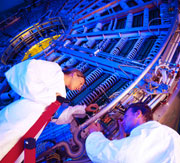Ghost Particles Break Cosmic Speed Limit

Research finds that neutrinos travel faster than the speed of light, turning Einstein's theory of relativity on its head
by Catherine McNiff
Gamers design new proteins that have disease-defying capabilities | Earthquake in Japan Causes Wide Destruction and a Nuclear Disaster | The final voyage of the space shuttle Atlantis marked the end of NASA's space shuttle program | Tornadoes Ravaged Parts of the Southeast U.S. in April and May 2011 | Kepler Telescope Eyes New Planets In 2011, the spotlight shone on the reclusive neutrino, an uncharged elementary particle that interacts so rarely with other particles that it is referred to as the "ghost particle." Results released in September were the culmination of three years' worth of experiments and measurements originating from CERN , the European Organization for Nuclear Research, whose "business is fundamental physics, finding out what the Universe is made of and how it works." Observations of more than 15,000 neutrino events led to the conclusion that the neutrinos travel at a velocity 20 parts per million above the speed of light; translation: the "little neutral one" moves 60 billionths of a second faster than light, thereby breaking the cosmic speed limit and turning Einstein's theory of relativity on its proverbial head. The research being carried out on the Franco-Swiss border is the work of an international collaboration called OPERA (Oscillation Project with Emulsion (T)racking Apparatus) composed of about 160 researchers from 30 institutions and 11 countries. The experiment involved sending a beam of neutrino particles three seconds long separated by up to 524 nanoseconds from CERN in Geneva through 700km of rock to a laboratory in Gran Sasso, Italy, where ultrasensitive bricks sensed the neutrinos' high-speed arrival after a grand distance travelled of 730 km (454 mi). Additional Testing Addresses SkepticismOf course, these results set the physics world to chattering. In November, the team carrying out the experiments answered initial criticisms and suggestions with a correction to the length of the neutrino bunches produced by the beam and released new results confirming the initial outcome. As is the norm in scientific study, the OPERA measurement are now open to independent testing and intense scrutiny of physicists around the world. The speeding neutrinos were clocked at rates which are, according to a CERN press release, "at odds with well-established laws of nature." Whether their records will stand the test of time or force us to redefine time itself. . .that remains to be seen. |
- More from 2011 Science News









